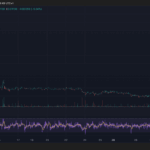
Why Owning Bitcoin Feels Mostly Challenging and Occasionally Rewarding
Reasons for Confidence
Robust editorial standards prioritizing precision, significance, and objectivity
Developed by experts in the field, carefully evaluated
Adhering to the highest benchmarks in journalism and publication
Robust editorial standards prioritizing precision, significance, and objectivity
The intricacies of fiscal dynamics are often hard to capture, but they’re crucial to understand.
Last week, Bitcoin experienced significant fluctuations, peaking at over $111,800 on May 23 before retreating to $109,600 today. Even with this sudden decline, the leading cryptocurrency closed the week around $110,000, currently priced at $109,770. While short-lived market shifts can unsettle some investors, an increasing number of analysts are turning their attention toward Bitcoin’s overall trajectory.
Associated Insights
Frustration and Endurance in Cryptocurrency
Thomas Fahrer, co-founder of Apollo, talked about the emotional complexities of holding Bitcoin. He remarked that for about 90% of the time, Bitcoin ownership can feel frustrating. However, he emphasizes the rewards for those who endure. Fahrer presented a price chart that extends from 2011 to a forecast for 2031, illustrating Bitcoin’s sustained rise through a logarithmic trendline.
Several key moments emerged from the chart. In 2015, Bitcoin plunged to approximately $212. In 2020, it stabilized around $5,000. In 2022, after reaching an all-time high above $67,000 the previous year, it fell to nearly $16,000. Nevertheless, despite these fluctuations, Fahrer insists that Bitcoin has maintained its long-term trajectory.
Holding Bitcoin often leads to financial gain, even if it feels frustrating most of the time.
This deflationary asset is engineered to appreciate in value over time, which can be challenging for many to fully grasp.
Despite widespread skepticism, the concept of value growth in money remains elusive.
A Design that Defies Conventional Understanding
Fahrer highlighted Bitcoin’s distinctive structure as a deflationary currency. Unlike the US dollar—which diminishes in worth as the supply increases—Bitcoin is limited to a supply cap of 21 million coins. The process known as halving occurs every four years, reducing the creation of new coins by half, thus ensuring that supply remains tight relative to demand over time.
He believes this concept continues to be misunderstood by many. The notion that currency can appreciate rather than depreciate conflicts with traditional views on spending and saving.
Statistics Speak Volumes
A Bitcoin investor known as Carl Menger provided a striking comparison: holding $100 in cash from 2020 to 2025 would see its purchasing power drop to about $76. Conversely, that same $100 invested in Bitcoin would increase to around $1,201 over the same duration.
This stark disparity demonstrates that while inflation erodes fiat currency, Bitcoin’s fixed supply reflects the opposite phenomenon during price increases. This visual representation is impactful.
Associated Insights
You Don’t Need to Own a Full Bitcoin
Robert Kiyosaki, the author of “Rich Dad Poor Dad,” contributed to the discourse by clarifying a common misconception: individuals do not have to purchase a complete Bitcoin to gain benefits. He argued that holding even a fraction, such as 0.01 BTC, could have considerable long-term implications should Bitcoin continue its upward trend.
Kiyosaki also posited that Bitcoin provides a new avenue for wealth accumulation beyond conventional assets like gold. This perspective resonates well with younger investors seeking alternatives.
Though daily market conditions may fluctuate unpredictably, the overarching message from these experts remains clear: while Bitcoin may challenge your patience, it has yet to deviate from its established trend.



















Post Comment